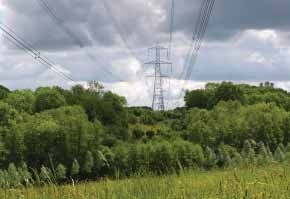PROGRESS AGAINST PYLONS: A ROUNDUP OF RECENT DEVELOPMENTS IN THE PYLONS SAGA
A roundup of recent developments in the pylons saga Reasons to be cheerful 1-2-3 sang the wonderfully gritty Essex voice of Ian Dury, and here in the more rural valleys of north Essex we do indeed have reasons to be cheerful.
Time was when some folk told us that confronting National Grid’s (NG’s) proposals to cover our landscape with pylons was futile: we were wasting our time and they would run roughshod over us. I hope that by now they realise that we can make a difference and that campaigning to protect our beautiful countryside from inappropriate development can succeed. The latest announcement from National Grid is a case in point. We have successfully moved the proposed site for one of National Grids huge installations to a far less detrimental location, a move that will bring great improvements to the natural beauty of an outstanding valley landscape.
Our work to establish the cultural heritage value of the Stour Valley, and the proposal to extend the AONB up to Cornard/Sudbury, lead to National Grid’s proposals to put their connection underground across the valley. This, along with the proposal to underground the Dedham Vale, was a huge step in the right direction. This little article, however, is not written to blow our own trumpet. Instead, it is intended to show that the call for energy infrastructure that does not despoil the countryside, is credible and worthy of your support and voice which will certainly be needed in the coming months.
Reasons to be cheerful 1 & 2
Undergrounding the Stour Valley and now…
A Sealing End Compound (SEC) is the installation that links underground and overhead cables. National Grid’s latest announcement of the proposed location for the Stour Valley’s western SEC is a triumph for our countryside. National Grid originally proposed a site beside ancient listed farm buildings, in a publicly accessible meadow strewn with rare flora, and overflown by even rarer fauna. The field boundaries are ancient and can be shown to date from before1600 and the land and ground water has the rare distinction of being completely free of modern agricultural chemicals, which may account for the presence of two ultra rare species of wild flower. This land is to be managed to the highest levels of stewardship and is in truth a subtle, though highly valuable, environmental asset for us all. Surely this landscape should not be spoiled with industrial installations that would corrupt it forever?
But we have success. National Grid now propose to place the SEC in a disused sand pit, beside a robust road built to take heavy vehicles. Indeed, the road was built by the Americans so that they could extract sand to build their airfield runways for the last war. Our research showed that such a location would allow four existing pylons to be removed allowing the County Wildlife designated woodland, at Ansels Grove, to be reinstated. Such a route also reduces the impact of the project on protected lanes. But perhaps most important of all, this decision will allow the beautiful tributary valley from Twinstead down to the Stour to be freed of most of its pylons and the views around the villages of this area will improve greatly.

Ansels Grove: currently cut through with overhead lines, will under NG’s proposals, be reinstated.
We should however be clear. This solution benefits the vast majority of us but will perhaps not suit all. That is always going to be the case and so our work now moves to minimising the impact of the works through concerted and informed pressure on NG.
So the campaign groups, of which SVU is just one, can claim some success and have hopefully developed some momentum for their ideas for better ways to develop the grid and keep the lights on. But there is still a long way to go, and this is where we need to ask for your continued support. Whether through consultation events or local government, you need to make your voice and opinions heard. Our landscape is just too valuable to let its natural beauty slip away through inaction. We all need to keep ourselves informed and make our views know. As part of their project National Grid have proposed to build a substation west of Twinstead with the preferred site being beside the Sudbury – Halstead road (A131). This, they say, is needed to replace the supply from the 132kv pylon line they propose to remove. However, we have made it clear that there are economic alternatives to this which do not industrialise the gateway to the heritage Gainsborough landscapes south of Sudbury. Put simply, the heavy equipment that is needed can be installed at National Grid’s existing site at Braintree, and an underground cable run from there to near Castle Heddingham to link to the local distribution grid. We have put this and other viable alternatives to a substation to NG, and their response has been interesting. They have exaggerated both the cost and land take for our proposals. We have countered this with technologies and costings from the very companies who do this sort of civil engineering for them. But why would NG want to exaggerate in this way? In part, the answer lies in the internal culture of their industry: they want their kit where they can see it – above ground and, sadly, that means in our view.
Google “Stour Valley Underground” and you will find our website which explains far more but the point to take away from this is simple: a substation in the beautiful Essex countryside is not necessary and we should oppose it vigorously.
Sometimes support for our ideas comes from surprising sources, NG being one. At NG’s Alphamstone consultation event, SVU presented panoramic photographs of the area that indicated that the best location for the SEC was toward pylon 005. Subsequently, NG did their own research and sent the results to us which confirmed our view. Accordingly, they have decided on such a location. Of course, this was more reassurance than pivotal data. More valuable to us going forward is another piece of information from NG. It seems that pylons can only keep their place in our countryside by consent of the Secretary of State. If a pylon becomes redundant, we can press the Secretary to rescind its consent and the energy company has to remove it.
NG have stated that they will remove all pylons made redundant by their project but, sadly, UK Power Networks, say they want to keep theirs. They could just end up with quite a few redundant ones, from Twinstead Tee through Wickham St Paul to near Castle Heddingham, if we have our way and no new substation is built. So we have NG to thank for the key to removing ALL redundant pylons and we expect to be lobbying the Secretary of State just as soon as we know how many and which pylons should be removed.
Of course our campaign addresses much more than our local Stour Valley pylon issues. We have always argued that the whole route from Bramford to Twinstead should be undergrounded and we can make a sound case for this in all areas. By way of example, you may recently have read that English Heritage have made plain that they consider NG to have understated the potential environmental impact of their proposals around Hintlesham Hall and its setting. But NG have presumably used the same judgmental criteria to determine the impact of their proposals across the entire route. Thus, English Heritage’s position undermines the whole of NG’s environmental impact work. We have long argued that the SSSI wood at Hintlesham should be cleared of the pylon that sits within it. Surely an overhead line cutting through a SSSI is utterly at odds with the very purpose of the designation. NG want to keep it simply because it is their consented asset. But to leave it there flies in the face of NG’s own “best practice” when siting two lines of pylons. However, two parallel lines in keeping with best practice would lead to further visual detriment of the area. Taking these points together, underground cabling is the right approach.
Past precedent provides a strong case for undergrounding in another area. The two Sealing End Compounds proposed for the area that includes Assington and Leavenheath will blight the views out of the areas whose visual amenity is to be protected with underground cabling. This is similar to the situation in Yorkshire some years back where two areas were proposed for undergrounding . The planners rejected the overhead line NG proposed to link the undergrounded ones, and the whole lot was eventually put beneath the landscape. The situation in the Assington area is very similar, and the same argument for undergrounding holds true for our local case. There are clearly more arguments for undergrounding than can be covered here but the case for underground cabling each individual area along NG’s route corridor is strengthening and thus so is the overarching case for a totally underground solution.
And so reason to be cheerful No.3 is to do with building on success, and grounds for a positive outlook. We have shown that we can come forward with better solutions, and that they can hold sway. The Amenity Group Coalition of which CSCA and SVU are members is our mutual campaigning organisation on the pylons issue and it enters 2013 fighting on many fronts. But we cannot succeed alone. We need your informed support through the current NG consultation process and pressure on government at all levels. If we win, everybody wins. The benefits will be huge and felt for generations.
David Holland
David Holland has been Chairman of Stour Valley Underground (SVU) since National Grid first mooted its proposals for a second line of pylons. He has been tenacious in his reasoning for undergrounding and protecting the countryside along the entire route and he is now snapping at NG’s heels about the proposed substation and why there is no need for this in the middle of the countryside. CSCA have supported him all the way.

